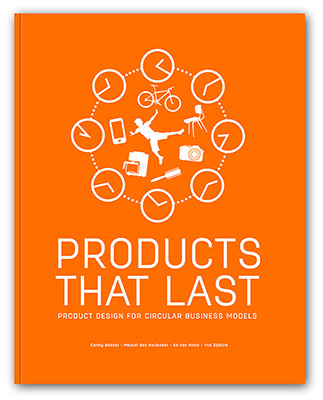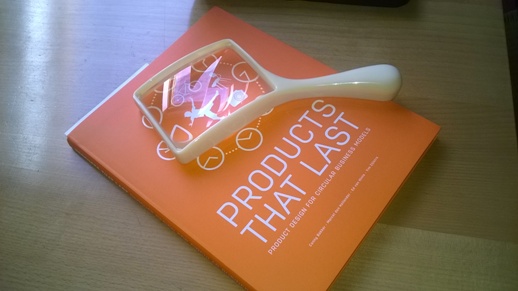
Phone:
+44(0)1935 812447
Mobile:
+44(0)7970 025924
Email:
jb@jb-ld.co.uk

Phone:
+44(0)1935 812447
Mobile:
+44(0)7970 025924
Email:
jb@jb-ld.co.uk

02-02-2015
 Products That Last - Product Design for Circular Business Models.
Products That Last - Product Design for Circular Business Models.This is the first of (probably) four reviews of a new book that discusses the necessity of shifting towards a design paradigm that has lifespan of product and re-use of components at its heart.
As usual, I'm reviewing as I read, so you get what comes into my head almost as soon as finish a section of the book.
Products That Last is published by TU Delft Library and is the result of a project supported by the Netherlands Enterprise Agency (RVO) as part of the Innovation-Oriented Research Programme 'Integrated Product Creation and Realisation' (IOP IPCR) of the Ministry of Economic Affairs.
Let me get this out of the way right at the beginning: this book is a difficult read. Not because of the content, which is a delight, but because the font size is so damned small. When I first looked at the book I suspected that the text had been made so small as an encouragement NOT to read the words – just look at the pictures. But that’s far from the case with this quality of content.
Maybe it was all about trying to reduce the number of pages, and therefore the material resources required to make the book. Or maybe there’s something in the Dutch diet that helps them sustain decent eyesight - certainly, one of the authors admits to having an eight-year old grandchild, so that puts them in my age bracket. Whatever, but if there's a dietary answer, please can I have some?
 As it was, the very-small-font-size problem led to a very Products-That-Last type of solution. My father’s magnifying glass must be over 50 years old by now; I remember it lying around the house when I was at school and I used it occasionally for setting fire to inappropriate things in the garden on sunny days. It’s a two-part construction; a glass lens and a plastic body. It could go on for centuries (and we must mean these things literally); I must add it to my will and leave it to a great-nephew or niece somewhere.
As it was, the very-small-font-size problem led to a very Products-That-Last type of solution. My father’s magnifying glass must be over 50 years old by now; I remember it lying around the house when I was at school and I used it occasionally for setting fire to inappropriate things in the garden on sunny days. It’s a two-part construction; a glass lens and a plastic body. It could go on for centuries (and we must mean these things literally); I must add it to my will and leave it to a great-nephew or niece somewhere.
And it’s kept in my mother-in-law’s chinoiserie writing desk, a piece that’s old enough to attract the interest of the Chinese cultural authorities if they ever got to know about it. Perhaps I shouldn’t have mentioned that.
And, really, those two examples help demonstrate the underlying philosophy of the book; that it’s LIFESPAN that ultimately matters in product design. A writing desk with a dodgy leg can (and should) live an active life for well over a century. And there’s no reason why something like a magnifying glass shouldn't go on far, far, longer. So long, in fact, that once the writing desk has finally collapsed, we can utilise the free power of the sun – via the magnifying glass – to return the biological nutrients still present in the desk (that’s wood to you and me) to the soil. And the magnifying glass could then look forward to the next century and beyond – waiting to set alight to the next generation of furniture – the arsonist!
Products That Last is an elegant book. It feels good in the hand and has one of those covers that suggests that it would take a coffee spill or two. It’s sort of A4 in size (Yvo Zijlstra, the credited graphic designer – and probably responsible for the painful font size – could probably tell me what the proper term of ‘sort of A4 might be). And it’s image-heavy. That is not a criticism; there are plenty of informative images here, including some very well-worked flow charts. I tend to distrust flow charts because they usually do one of two things; either they make something that’s very simple look more complex – or they take something complex and hope to make it look more simple – which rarely works. These flow charts take a complex idea and render it understandable. They do need effort and to be taken seriously, but the final sense of enlightenment does repay the effort.
Thus far, I’ve read the first of four chapters, and the message is simple – and difficult. Let's face it, any work demanding a wholesale change to the way that we do things that is brave enough to preface the argument by answering its own 'how do we do this' question with 'It Depends' is alway a going to be a bit of a roller coaster.
But as there is no way on earth (again , literally) that we can continue with our 'take-make-waste' throwaway life style, it is clear that something must be done. A new paradigm is needed; one that sees Product Value encompass a product design and manufacture philosophy where every component is evaluated for its potential lifespan. And not necessarily as a single iteration, but beyond into further generations of product manufacture.
In the lighting industry, we already understand something of that. If we think of a light fixture as luminaire+lamp, then light fixtures have always been designed to accept component failure - except we call it a lamp. In time, filament lamps give way to energy-saving CFLs, which in turn give way to even more efficient LEDs - while the luminaire body continues to function through the years until that finally fails. So we already understand about the exhaustion of components – it’s called a failed lamp.
My concern over the future of LED lighting technology is the extent to which a new family of product designers understand that simple exercise of removing a failed component and replacing it with a later iteration of the same thing – without throwing away the entire fixture. The history of electronics-based design has not been a happy one when it comes to re-use or component replacement. If anything, its accelerated the speed of waste generation. Given the likely future for LED lighting, that is a situation that has to be challanged.
More to follow, as we enter the realm of 'What Is Your Business Model Archetype' . . . . . no, nor me.
To learn more about me and (sort of) justify my standing up and talking about stuff like this, click HERE!
Greenwashing: a guidline for good behaviour
The elephant box in the room
What Lighting Designers Should be Looking For . . . and Asking For
The Children's Fire
Products That Last - Redux
Products That Last - Review No.3
Products That Last - Review No.2
Products That Last - Review No.1
Products That Last
Talking about Waste - as we were . . .
Sustainability - They Seek it Here, They Seek it There . . .
Sustainability - the core message
The Life and Times of the LED - a series in ten parts
Sustainability: They Seek it Here; They Seek it There . . .
PUBLISHED ARTICLES
John Bullock writes a regular column for lighting magazines. You can find all of the archived pieces here.
BLOGS - LIGHTING DESIGN
John Bullock writes about all things and anything concerning architectural lighting design; new technologies and old lamps; anything,really.
HOME LIGHTING CONSULTANT
John Bullock designs innovative lighting designs for people's homes. By working closely with clients he is able to deliver solutions that meet - and exceed - their expectations.
BLOGS - CPD RIBA CORE PROGRAMME 2015
John Bullock will be presenting a seminar on latest lighting design and technologies as part of the RIBA CPD Core programme 2015
BLOGS - SUSTAINABILITY
John Bullock believes that the UK lighting industry needs to embrace a sustainable way of delivering good quality product through good design, fabrication and end-of-life management.
BLOGS - LIGHTING HEALTH AND WELLBEING
Lighting has a vital role to play in our health and wellbeing.

CONDUIT (6) - Lighting for Winter Gardens
CONDUIT 5: Home Lighting - LED Lighting (2)
FX Magazine: Lighting Focus - Sustainability (Issue 258)
CONDUIT 4: Home Lighting - LED Lighting (1)
Can Smart Lighting Save The Planet?
CONDUIT 3: Home Lighting - The Bathroom
Can Lighting Save Us From Ourselves . . . NO!
CONDUIT 2: Home Lighting - The Dining Room
Read More
John Bullock Lighting Design
4 Miller Way
Sherborne
Dorset
DT9 3SG
England
Website designed by Alacrify